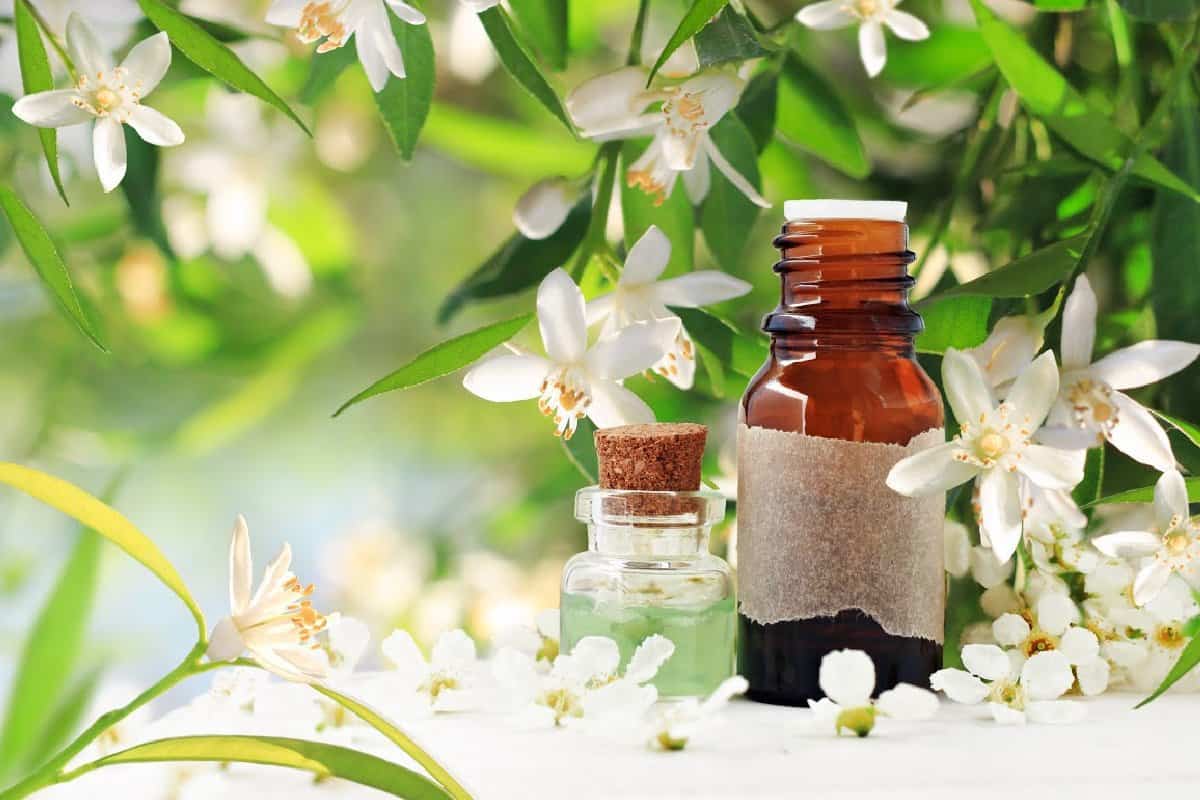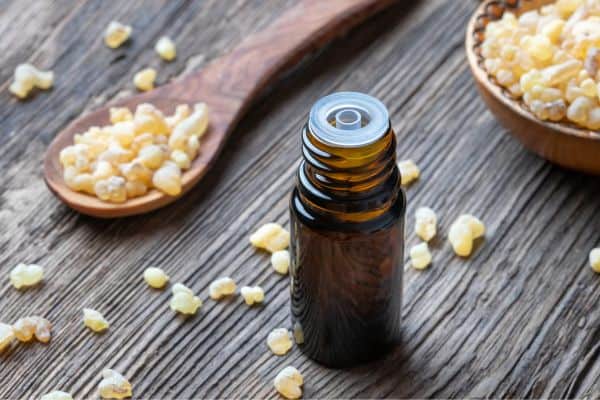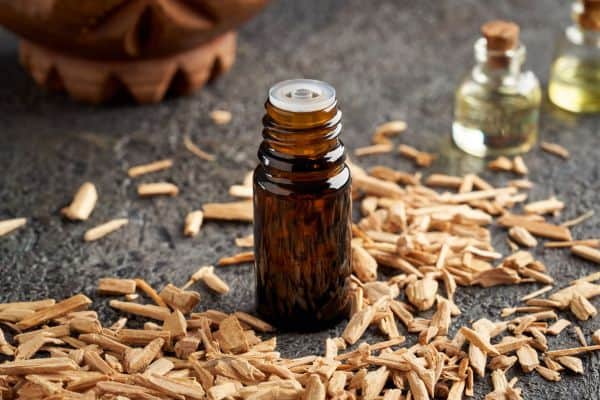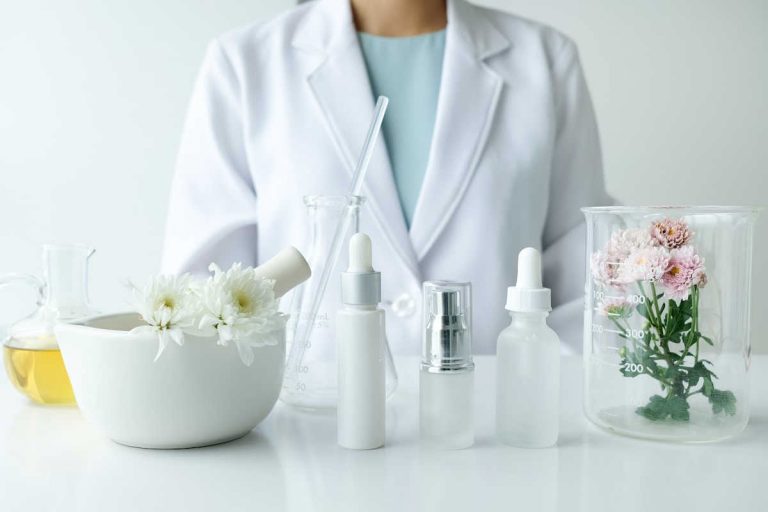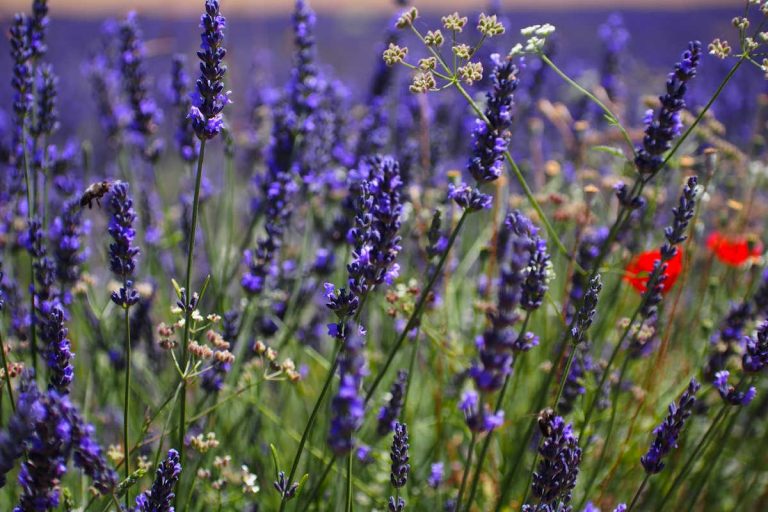With so many choices out there, having a list of the best essential oils for natural skin care recipes is a must-have resource for any handmade entrepreneur.
Essential oils are incredibly concentrated; using the wrong amount or a type that isn’t safe for topical use can cause serious health concerns for the user.
As a skin care maker, your customers are trusting that the formulas you create have been researched and are safe to use as directed.
This article will set you up for success by discussing the basics of essential oils, how to use them safely, and the skin care benefits of twenty-seven different oils to consider for your natural recipes.
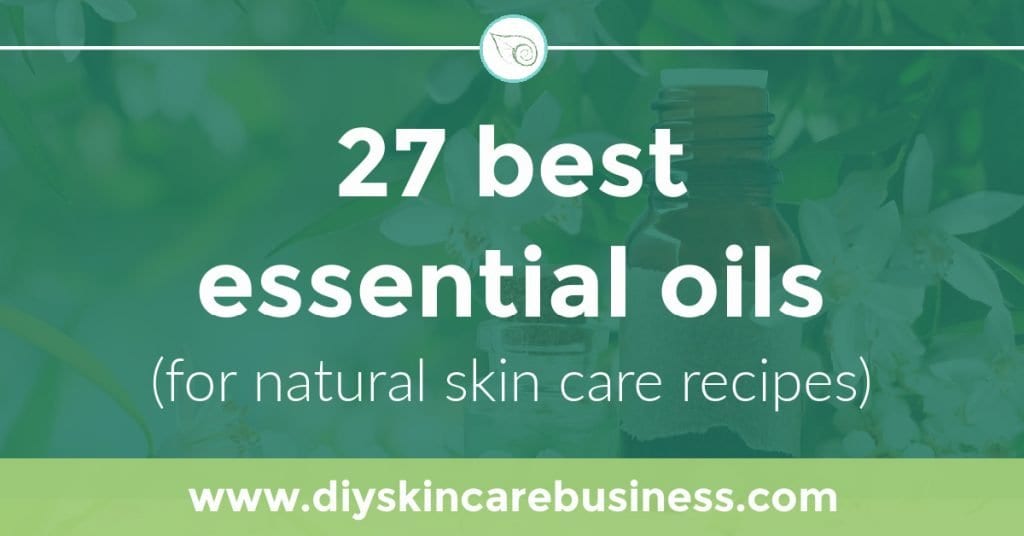
This post may contain affiliate links, meaning I get a commission if you decide to make a purchase through my links (at no cost to you). Please read the disclosure for more information.
What is an Essential Oil?
An essential oil is an aromatic liquid that is extracted from the leaves, stems, flowers, bark, roots, or other plant elements through steam distillation or cold pressing.
Essential oils are said to provide psychological and physical therapeutic benefits by either applying to the skin (diluted) or through inhalation.
These oils are so strong and so concentrated that the majority of skin care recipes suggest a maximum of 1% – 2% in any given formula.
This is not a lot…one percent equals out to be 5-6 drops of essential oil per one ounce of carrier oil.
Some essential oils have their own topical maximums to prevent skin sensitization; for example, Lemongrass (Cymbopogon citratus) has a max of 0.7% and needs to be used along with oils high in d-limonene.
This example shows the extreme respect and care that needs to be taken with using essential oils.
You are responsible for knowing exactly what you’re putting into every skin care product you create for others.
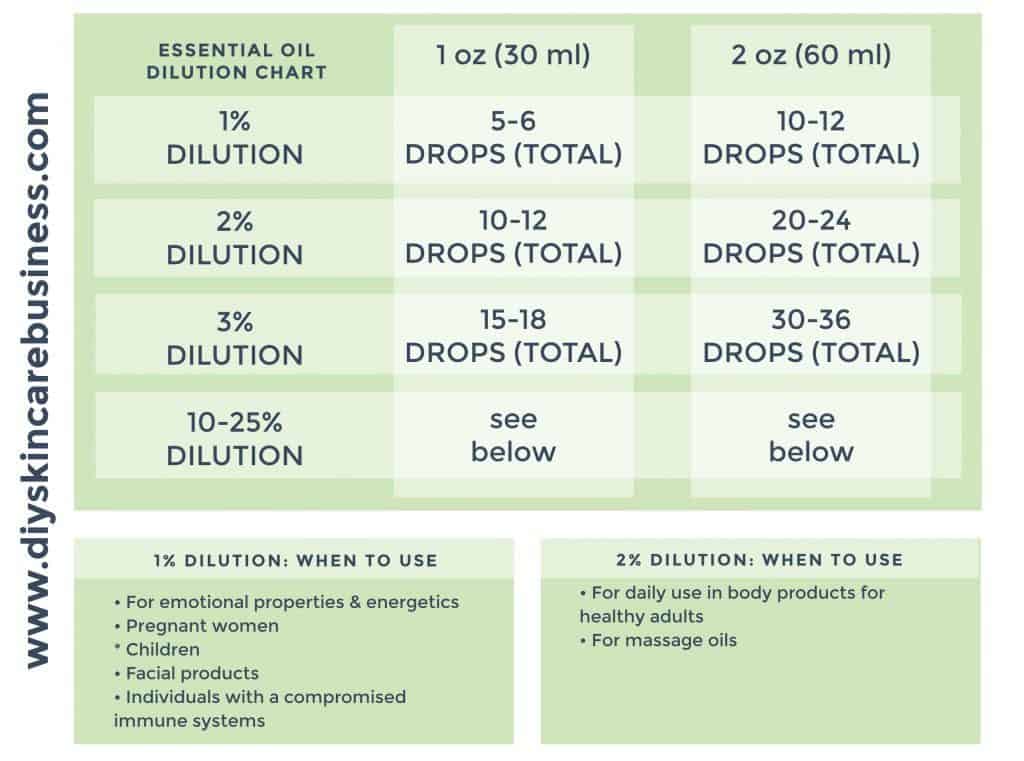
(You can get a copy of this essential oil dilution chart in the free Skin Care Maker’s Reference Pack.)
Essential Oils and Chemistry Overview
Essential oils are made up of compounds that are organized by chemical family, and you can make some broad generalizations about an oil based on those compounds.
Understanding these compounds, also known as constituents, is crucial to creating a safe formulation.
For example, oils that are high in the ether chemical family can burn the skin and cause toxicity concerns, and oils high in the phenol family can cause dermatitis and sensitization.
On the other hand, some chemical families are (generally) FANTASTIC for the skin.
For example, many oils high in the sesquiterpenol family are considered to be skin healing and anti-inflammatory, and the monoterpenol family is known for being non-toxic and mild on the skin.
This very quick overview is not all-inclusive; it is simply a measure to demonstrate that essential oils are not included in products just to make them smell good – there is a LOT of science going on behind those aromas.
Yet again, you are responsible for the safety of your handmade products – know what you’re adding to those formulas!
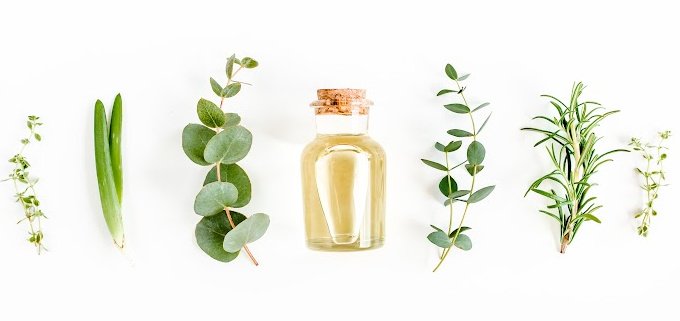
Why the Chemistry Talk? Isn’t this a Natural Skin Care Website?
If you hopped onto this site because you were looking for information about chemical-free skin care, you might be confused as to why we’re talking about chemistry in conjunction with essential oils.
Worry not. You’re still in the right place!
When individuals talk about ‘chemical-free’ products, they’re really referring to ‘synthetic-chemical-free products’.
Synthetic meaning ‘manmade to imitate a natural product’. We definitely don’t want synthetic chemicals in our ingredient lists.
But not all chemicals are bad…
Water is a chemical. Oxygen is a chemical. Dirt is made up of a variety of chemical elements.
All of these natural chemicals that we need to survive are made up of carbon compounds (more specifically, carbon-hydrogen bonds), and all fall under the umbrella of ‘organic chemistry’.
Essential oils fall under this same umbrella and are made up of carbon, hydrogen, and (sometimes) oxygen.
All beautifully natural.
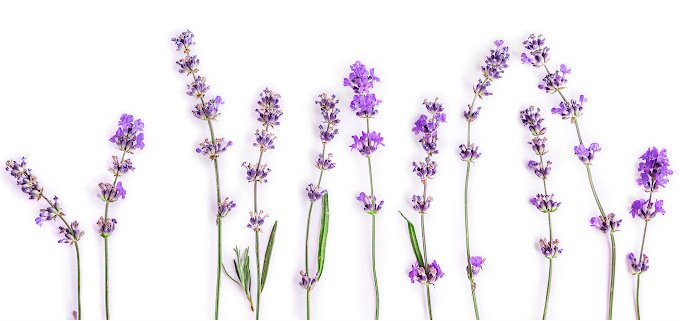
Do I Need to Know Chemistry to Make Skin Care Products?
It depends.
As touched on above, essential oils are natural, but not all essential oils are good for the skin.
This means that if you want to formulate your own recipes, you definitely need education and a firm understanding of dilution rates, how to read an oil’s GC/MS report, and how to combine oils safely.
However, you don’t necessarily need all of this background if you are following someone else’s recipes (which I did for nearly five years before formulating my own – it’s how most handmade skin care entrepreneurs start!).
What you DO need to know is if the author of those recipes is an educated and credible resource.
There are more and more ‘DIY’ websites out there with handmade skin care recipes that aren’t based on research and aren’t taking safety precautions of these HIGHLY concentrated chemicals seriously.
Anyone can start a blog and publish a recipe in an afternoon.
That doesn’t mean the information provided is safe to make and use, especially for resale to others.
While most websites and skin care recipes won’t go into the chemistry details of their blends, make sure that the author has a real education in aromatherapy and essential oil studies.
You’ll want to find an individual that has been certified in aromatherapy from a school that is approved by the NAHA (National Association for Holistic Aromatherapy) and the AIA (Alliance of International Aromatherapists).
If you cannot find that information easily on the website you are on, contact the author of the article and they should be able to tell you where they graduated from and provide their credentials to verify their certification.
(Mine? Oh yes, they’re right here: Christine Glaser, C.A. credentials)

Can I Apply Essential Oil Directly to Skin?
No.*
Essential oils always need to be combined with a carrier before being applied to the skin.
This could be in a carrier oil, unrefined butter and/or wax, or a combination of these.
*While there are technically a few reasons that you could use certain essential oils undiluted (topically), that is on a case-by-case basis. For your use as a business owner, you should never provide undiluted essential oils as skin care products to your customers.
What are the Best Essential Oils for Your Face?
In the 27 essential oils discussed below, you will be able to quickly highlight which oils are beneficial for different types of skin: oily, sensitive, acne-prone, etc.
The best essential oil for one person’s facial skin may not be the best choice for another.
As a skin care business owner, you should be creating a variety of products for your customers, as there is not one ‘miracle product’ for everyone.
Note: Facial products should only contain a 1% maximum dilution rate (5-6 drops of essential oil per ounce of carrier)…other areas of the body can handle a 2% dilution rate (10-12 drops of essential oil per ounce of carrier) for daily use on the average healthy adult.
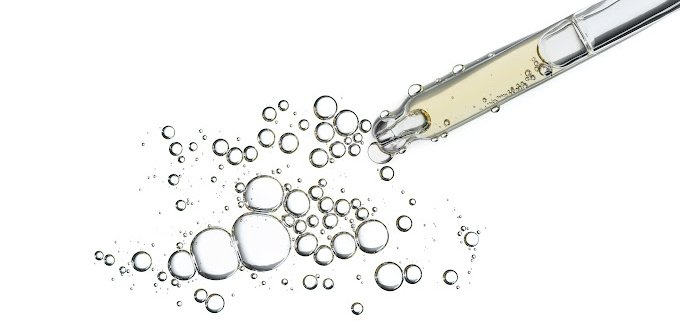
A Note About the FDA and Discussing Essential Oils
The FDA, also known as the Food and Drug Administration (a U.S. government agency), is responsible for protecting public health and overseeing the safety of all drugs and cosmetics.
This includes the statements that companies make about their products (product names, label claims, or implied cures).
As natural skin care makers, our products fall under the ‘cosmetics’ category, and we cannot use language that suggests a medical treatment.
In the descriptions of the essential oils below, I have verbiage in each ‘benefits’ section that cannot be used when selling your skin care products.
For example, in the first oil below (Cedarwood, Juniperus Virginiana), it is noted as being cell regenerative and healing. Those same words on a product label or description would go against FDA regulations. Use the provided descriptors to guide you towards a non-medical outcome, such as “Fresh Glow” or “After Sun Serum”.
(Wondering why I can use these words to describe them on this blog? The FDA allows such language for educational websites, such as this one, for describing therapeutic properties…I am not selling any physical skin care product on this site.)
Read about this firsthand in the FDA Cosmetics Labeling Guide.
If you want more direction on how to label and market your skin care products to meet all of the regulations, check out the book Soap & Cosmetic Labeling by Marie Gale.
27 Best Essential Oils for Handmade Skin Care Businesses
Without further ado, the best essential oils for natural skin care recipes!
Please note that the text information below refers to the corresponding type of essential oil in general (the most common data).
If you click on the underlined essential oil title or photo, you will be sent to a specific oil batch that will come from one country and dominant chemical family based on its GC/MS report (available in the oil’s ‘Test Report’ section).
While I noted precautions under *some* of the oils, these are NOT the only safety measures to take.
Research each oil in depth (from valid sources and your chosen vendor) to understand topical maximums and irritation possibilities before using it in any skin care product for yourself or to sell to others.
#1: Cedarwood Essential Oil
Juniperus virginiana
- Chemical Families: Sesquiterpenes, Sesquiterpenols
- Botanical Family: Cupressaceae
- Plant Part: Wood
- Note: Base
- Country of Origin: USA
- Extraction Method: Steam Distilled
- Aroma: mild, dry, light, fresh, resinous, balsamic, earthy
Skin care benefits of Virginian Cedarwood essential oil: Astringent and antiseptic qualities especially useful for acne; cicatrisant (cell regenerative, healing); wound healing for superficial lesions.
Other benefits for holistic skin care and health: Sedative for the nervous system; relaxing and calming.
Note: Some sources say to not use Cedarwood during pregnancy, but there is no research to support this with Juniperus virginiana.
Skin Care Recipes that Use Cedarwood Essential Oil:
#2: Chamomile (German) Essential Oil
Matricaria recutita
- Chemical Family: Sesquiterpenes, Sesquiterpenols, Oxides
- Botanical Family: Asteraceae
- Plant Part: Flowers
- Note: Middle-Base
- Countries of Origin: England, Europe, N. Asia
- Extraction Method: Steam Distilled
- Aroma: strong, bitter, herbal, slightly fruity
Skin care benefits of German Chamomile essential oil: Nourishes the skin, anti-inflammatory, cicatrisant (supports the formulation of granulation tissue)
Other benefits for holistic skin care and health: Calms the nervous system (helpful for anxiety, nervous tension, headaches, sleep)
#3: Chamomile (Roman) Essential Oil
Chamaemelum nobile
- Chemical Family: Monoterpenes, Monoterpenols, Ketones, Esters
- Botanical Family: Asteraceae
- Plant Part: Flowers
- Note: Middle-Top
- Countries of Origin: France, Italy, England
- Extraction Method: Steam Distilled
- Aroma: sweet, warm, fruity, herbal, intense
Skin care benefits of Roman Chamomile essential oil: Helps to counteract inflammation and irritated skin.
Other benefits for holistic skin care and health: Calming, sedative effect helpful for stress and anxiety, supports sleep.
Skin Care Recipes that Use Roman Chamomile Essential Oil:
#4: Clary Sage Essential Oil
Matricaria recutita
- Chemical Family: Sesquiterpenes, Sesquiterpenols, Oxides
- Botanical Family: Asteraceae
- Plant Part: Flowers
- Note: Middle-Base
- Countries of Origin: England, Europe, N. Asia
- Extraction Method: Steam Distilled
- Aroma: strong, bitter, herbal, slightly fruity
Skin care benefits of Clary Sage essential oil: Antibacterial and anti-inflammatory actions make this a fantastic choice for anti-acne blends (active against Staphylococcus epidermidis).
Other benefits for holistic skin care and health: Uplifting, relaxing, and antidepressant properties are ideal for emotional issues.
Skin Care Recipes that Use Clary Sage Essential Oil:
#5: Eucalyptus Essential Oil
Eucalyptus globulus
- Chemical Families: Monoterpenes, Oxides
- Botanical Family: Myrtaceae
- Plant Part: Leaves
- Note: Top
- Countries of Origin: Spain, China, Australia
- Extraction Method: Steam Distilled
- Aroma: powerful, fresh, penetrating, medicinal, green notes
Skin care benefits of Eucalyptus essential oil: Astringent (great for oily skin, as it reduces gland size); skin nourishing, skin penetration enhancing (also active against Propionibacterium acnes).
Note: Irritation and sensitization when oxidized. Do not use with children under the age of 10.
Skin Care Recipes that Use Eucalyptus Essential Oil:
#6: Frankincense Essential Oil
Boswellia carterii
- Chemical Families: Monoterpenes, Sesquiterpenols, Monoterpenols, Sesquiterpenes
- Botanical Family: Burseraceae
- Plant Part: Resin/Gum
- Note: Base
- Country of Origin: Somalia
- Extraction Method: Steam Distilled
- Aroma: resinous, coniferous, pine-like, woody, spicy nuances
Skin care benefits of Frankincense essential oil: Antioxidant, anti-inflammatory, antibacterial, cicatrisant; useful in blends for protecting the skin and reducing inflammation.
Other benefits for holistic skin care and health: Calms stress, focuses the mind, deepens meditation.
Skin Care Recipes that Use Frankincense Essential Oil:
More reading: Frankincense Essential Oil Benefits for Skincare (with Recipe Ideas)
#7: Geranium Essential Oil
Pelargonium x asperum
- Chemical Families: Sesquiterpenes, Monoterpenols, Sesquiterpenols, Ketones, Esters
- Botanical Family: Geraniaceae
- Plant Part: Leaves
- Note: Middle
- Countries of Origin: Egypt, China, Reunion
- Extraction Method: Steam Distilled
- Aroma: fresh, rosey, herbaceous
Skin care benefits of Geranium essential oil: Helps manage excess oil or dryness; useful for chronic skin inflammation.
Other benefits for holistic skin care and health: Uplifting, anti-depressant effects and anxiety-relieving.
Skin Care Recipes that use Geranium Essential Oil:
#8: Grapefruit (Organic) Essential Oil
Citrus paradisi
- Chemical Family: Monoterpenes
- Botanical Family: Rutaceae
- Plant Part: Fresh Fruit Rind
- Note: Top
- Countries of Origin: Spain, USA, Argentina
- Extraction Method: Cold Pressed
- Aroma: sparkling, sharp, sweet body
Skin care benefits of Organic Grapefruit essential oil: Skin penetration enhancer, cooling effect, contracts and tightens (great for toning blends).
Other benefits for holistic skin care and health: Anxiety-relieving, uplifting effects for the mind and emotions.
Note: Always buy the organic version of cold-pressed citrus oils – pesticides from fruit rinds can be present in essential oils of non-organic batches.
Grapefruit oil is slightly phototoxic – use at 4% maximum; oxidized oils increase the chance of skin irritation.
Skin Care Recipes that Use Grapefruit Essential Oil:
#9: Helichrysum Essential Oil
Helichrysum italicum
- Chemical Families: Monoterpenes, Sesquiterpenes, Monoterpenols, Sesquiterpenols, Ketones, Esters
- Botanical Family: Asteraceae
- Plant Part: Flowers
- Note: Middle
- Countries of Origin: Corsica, USA, Bosnia, Croatia
- Extraction Method: Steam Distilled
- Aroma: rich, sweet, fruity, tea-like, warm and herbaceous dry out
Skin care benefits of Helichrysum essential oil: Skin nourishing, skin healing, reduces inflammation and allergies that manifest in the skin.
Other benefits for holistic skin care and health: Uplifting, anti-depressant.
Note: Not for use on deep wounds.
Skin Care Recipes that Use Helichrysum Essential Oil:
#10: Jasmine Absolute
Jasminum grandiflorum
- Chemical Families: Sesquiterpenes, Monoterpenols, Ketones, Esters
- Botanical Family: Oleaceae
- Plant Part: Flowers
- Note: Middle-Base
- Countries of Origin: India, Egypt, France, Italy
- Extraction Method: Solvent
- Aroma: intense, rich, heavy, diffusive, lily-like, green notes
Skin care benefits of Jasmine Absolute: Useful for dry, sensitive, and sun-damaged skin; cicatrisant (protective and regenerating); active against Propionibacterium acnes.
Other benefits for holistic skin care and health: Mood regulator, reduces anxiety.
Skin Care Recipes that Use Jasmine Absolute:
#11: Juniper Berry Essential Oil
Juniperus communis
- Chemical Families: Monoterpenes, Sesquiterpenes
- Botanical Family: Cupressaceae
- Plant Part: Ripe Fruit
- Note: Top-Middle
- Countries of Origin: Macedonia, Croatia, India
- Extraction Method: Steam Distilled
- Aroma: fresh, terpenic, coniferous, resinous, woody
Skin care benefits of Juniper Berry essential oil: Skin penetration enhancer, anti-inflammatory, astringent, helps to clean and heal infected areas; a good choice for acne blends.
Note: Use in low dilutions on the skin.
#12: Lavender Essential Oil
Lavandula angustifolia
- Chemical Families: Monoterpenols, Esters
- Botanical Family: Lamiaceae
- Plant Part: Flowers
- Note: Middle-Top
- Countries of Origin: India, S. France, Italy, Bulgaria
- Extraction Method: Steam Distilled
- Aroma: fresh, light, sweet-herbal, woody, sometimes fruity
Skin care benefits of Lavender essential oil: Known for its ability to heal burns, ulcers, itching, rashes, irritations, infections, wounds, and other skin damage.
Other benefits for holistic skin care and health: Sedative, anxiety-relieving, stress-relieving; supports sleep
Skin Care Recipes that use Lavender Essential Oil:
- Alkanet lip tint recipe
- Mica tinted lip balm recipe
- Organic cuticle salve recipe
- Cold Process Gardener’s Soap
- Cold Process Fresh Indigo Soap
- Mature Skin Facial Serum
- Sensitive Skin Facial Serum
- Dry Skin Facial Serum
- Calming Laundry Powder
- Peaceful Laundry Powder
- Rejuvenating Laundry Powder
- Warming muscle balm recipe
- Aphrodite’s Kiss Organic Lip Balm
- Lavender Lime Organic Lip Balm
- Lavender Mint Organic Lip Balm
- Sweet Dreams Organic Lip Balm
More reading: How to Use Lavender Essential Oil for Holistic Skincare
#13: Lemon (Organic) Essential Oil
Citrus limon
- Chemical Families: Monoterpenes, Aldehydes
- Botanical Family: Rutaceae
- Plant Part: Fresh Fruit Rind
- Note: Top
- Countries of Origin: Spain, Italy, France, S. Africa
- Extraction Method: Cold Pressed
- Aroma: fresh, sharp, sweet
Skin care benefits of Organic Lemon essential oil: Antibacterial, anti-inflammatory, skin penetration enhancer, astringent (can contract and tighten tissues); helpful for acne blends.
Other benefits for holistic skin care and health: Uplifting, antidepressant, decreases psychological stress.
Note: Always buy the organic version of cold-pressed citrus oils – pesticides from fruit rinds can be present in essential oils of non-organic batches.
Lemon oil is phototoxic – use at 1-2% maximum; oxidized oils increase the chance of skin irritation.
Skin Care Recipes that Use Lemon Essential Oil:
More reading: How to Use Lemon Essential Oil for Holistic Skincare
#14: Lemongrass Essential Oil
Cymbopogon citratus
- Chemical Families: Monoterpenes, Monoterpenols, Aldehydes
- Botanical Family: Poaceae
- Plant Part: Grass
- Note: Top-Middle
- Countries of Origin: India, Nepal, S. Africa
- Extraction Method: Steam Distilled
- Aroma: dominating, lemony, herbal
Skin care benefits of Lemongrass essential oil: Anti-inflammatory, antifungal, antibacterial; helps to manage acne and skin infections.
Other benefits for holistic skin care and health: Relaxing, calms the mind, antidepressant properties.
Note: Avoid use with antidepressant medications; use at 0.7% maximum; combine with oils that are rich in d-limonene to reduce the risk of irritation.
Skin Care Recipes that Use Lemongrass Essentail Oil:
#15: Marjoram (Sweet) Essential Oil
Origanum majorana
- Chemical Families: Monoterpenes, Monoterpenols
- Botanical Family: Lamiaceae
- Plant Part: Flowers, Leaves
- Note: Middle
- Countries of Origin: France, Spain, S. Africa
- Extraction Method: Steam Distilled
- Aroma: warm, herbal, camphoraceous, woody, spicy
Skin care benefits of Sweet Marjoram essential oil: Healing; can alleviate skin inflammation and allergies.
Other benefits for holistic skin care and health: Helpful for stress, tension, anxiety, and insomnia; sedating actions.
#16: Myrrh Essential Oil
Commiphora myrrha
- Chemical Families: Sesquiterpenes, Ketones
- Botanical Family: Burseraceae
- Plant Part: Resin/Gum
- Note: Base
- Countries of Origin: Ethiopia, S. Africa
- Extraction Method: Steam Distilled
- Aroma: spicy, balsamic, medicinal
Skin care benefits of Myrrh essential oil: Skin healing, anti-inflammatory, regenerating potential; great for blends intended for mature skin and/or eczema.
Other benefits for holistic skin care and health: Calming; commonly used for meditation.
Note: Not for use during pregnancy or breastfeeding.
Skin Care Recipes that Use Myrrh Essential Oil
#17: Neroli Essential Oil
Citrus aurantium var. amara
- Chemical Families: Monoterpenes, Monoterpenols, Sesquiterpenols, Esters
- Botanical Family: Rutaceae
- Plant Part: Flowers
- Note: Middle
- Countries of Origin: Italy, Tunisia, Morocco, Egypt
- Extraction Method: Steam Distilled
- Aroma: strong floral-citrus, slightly bitter, faint dry out
Skin care benefits of Neroli essential oil: Antibacterial, anti-inflammatory.
Other benefits for holistic skin care and health: Soothing and calming to the nervous system; uplifting, anxiety-relieving.
Note: This oil is very powerful and strong, use only 1-2 drops. Avoid solvent-extracted versions, subject to frequent adulteration.
Skin Care Recipes that Use Neroli Essential Oil:
#18: Orange (Organic) Essential Oil
Citrus sinensis
- Chemical Family: Monoterpenes
- Botanical Family: Rutaceae
- Plant Part: Fresh Fruit Rind
- Note: Top
- Countries of Origin: Italy, Israel, Brazil, S. Africa
- Extraction Method: Cold Pressed
- Aroma: fresh, fruity, light
Skin care benefits of Organic Sweet Orange essential oil: Skin penetration enhancer, anti-inflammatory, astringent (can tone the skin and reduce secretions).
Other benefits for holistic skin care and health: Relaxing, anxiolytic, calming.
Note: Always buy the organic version of cold-pressed citrus oils – pesticides from fruit rinds can be present in essential oils of non-organic batches. Use at a 1-2% dilution to avoid irritation.
Skin Care Recipes that Use Sweet Orange Essential Oil:
- Oily Skin Facial Serum
- Peaceful Laundry Powder
- Uplifting Laundry Powder
- Aphrodite’s Kiss Organic Lip Balm
- Autumn Spice Organic Lip Balm
- Orange Ginger Organic Lip Balm
- Sweet Dreams Organic Lip Balm
More reading: How to Use Sweet Orange Essential Oil for Holistic Skincare
#19: Palmarosa Essential Oil
Cymbopogon martinii var. motia
- Chemical Families: Monoterpenols, Aldehydes, Esters
- Botanical Family: Poaceae
- Plant Part: Grass
- Note: Middle
- Countries of Origin: India, Nepal, Seychelles Islands
- Extraction Method: Steam Distilled
- Aroma: sweet, delicate, rosy-floral, herbaceous
Skin care benefits of Palmarosa essential oil: Antioxidant, anti-inflammatory, stimulates cell regeneration, balances sebum production; a great oil for dry skin, dermatitis, eczema, psoriasis, and skin infections.
Other benefits for holistic skin care and health: Calming, reduces anxiety, supports sleep.
Note: Maximum topical use 6.5%.
Skin Care Recipes that Use Palmarosa Essential Oil:
#20: Patchouli Essential Oil
Pogostemon cablin
- Chemical Families: Sesquiterpenes, Sesquiterpenols
- Botanical Family: Lamiaceae
- Plant Part: Leaves
- Note: Base
- Countries of Origin: Indonesia, India
- Extraction Method: Steam Distilled
- Aroma: rich, intense, earthy, balsamic, rooty, peppery
Skin care benefits of Patchouli essential oil: Anti-inflammatory, antibacterial, moisturizing, cooling; great in blends for dryness, scarring, eczema, and other skin disorders.
Other benefits for holistic skin care and health: Balancing oil; uplifting, reduces stress and anxiety, calming effects.
Skin Care Recipes that Use Patchouli Essential Oil:
- Organic cuticle salve recipe
- Organic acne scar salve recipe
- Dry Skin Facial Serum
- Aphrodite’s Kiss Organic Lip Balm
More reading: How to Use Patchouli Essential Oil for Holistic Skincare
#21: Rose Absolute
Rosa x damascena
- Chemical Families: Monoterpenols, Phenols
- Botanical Family: Rosaceae
- Plant Part: Flowers
- Note: Middle-Base
- Countries of Origin: Bulgaria, Turkey, India
- Extraction Method: Solvent
- Aroma: rich, sweet, waxy, honey-like
Skin care benefits of Rose Absolute: Skin regenerating, reinforces skin barrier function, astringent; useful for blends intended for dry skin and acne; can inhibit Proprionibacterium acnes.
Other benefits for holistic skin care and health: Hormone balancing, relaxing, uplifting, antidepressant effects.
Note: Maximum 2.5% topical use.
Skin Care Recipes that Use Rose Absolute:
#22: Rosemary Essential Oil
Rosmarinus officinalis ct. 1,8 cineole
- Chemical Families: Monoterpenes, Sesquiterpenes, Monoterpenols, Ketones, Oxides
- Botanical Family: Lamiaceae
- Plant Part: Leaves, Twigs
- Note: Top-Middle
- Countries of Origin: Spain, France, S. Africa
- Extraction Method: Steam Distilled
- Aroma: strong, fresh, herbal, woody, resinous
Skin care benefits of Rosemary essential oil: Antibacterial, astringent (regulates/decreases secretions of hair follicles); can decrease radical-induced skin damage; active against Proprionibacterium acnes; a great choice for regenerating and acne blends.
Note: Avoid during pregnancy; not for use on children under the age of 5, use in very small dilutions with children 5-10 years old.
Skin Care Recipes that Use Rosemary Essential Oil:
- Gardener’s Cold Process Soap
- Oily Skin Facial Serum
- Energizing Laundry Powder
- Peaceful Laundry Powder
- Herbal Blend Organic Lip Balm
- Peppermint Rosemary Organic Lip Balm
- Winter Forest Organic Lip Balm
#23: Sandalwood Essential Oil
Santalum album
- Chemical Families: Sesquiterpenes, Sesquiterpenols
- Botanical Family: Santalaceae
- Plant Part: Trunk
- Note: Base
- Countries of Origin: Hawaii, India, Indonesia, Australia
- Extraction Method: Steam Distilled
- Aroma: soft, sweet, woody, musky
Skin care benefits of Sandalwood essential oil: Moisturizing; use in blends with stronger oils to protect the skin; alleviates acne, dermatitis, eczema; skin health maintenance.
Other benefits for holistic skin care and health: Calming oil that quiets the mind and settles the breath; sedative.
Note: Use at a 2% maximum; subject to frequent adulteration.
Skin Care Recipes that Use Sandalwood Essential Oil:
#24: Tea Tree Essential Oil
Melaleuca alternifolia
- Chemical Families: Monoterpenes, Sesquiterpenes, Monoterpenols, Oxides
- Botanical Family: Myrtaceae
- Plant Part: Leaves
- Note: Top-Middle
- Countries of Origin: Australia, S. Africa
- Extraction Method: Steam Distilled
- Aroma: medicinal, spicy
Skin care benefits of Tea Tree essential oil: Antibacterial, anti-inflammatory; a great choice for acne blends (reduces lesions, active against Propionibacterium acnes).
Note: May cause irritation on sensitive skin.
Skin Care Recipes that Use Tea Tree Essential Oil:
#25: Thyme Linalool Essential Oil
Thymus vulgaris ct. linalool
- Chemical Families: Monoterpenes, Monoterpenols
- Botanical Family: Lamiaceae
- Plant Part: Flowers, Leaves
- Note: Top-Middle
- Countries of Origin: Spain, France, S. Africa
- Extraction Method: Steam Distilled
- Aroma: fresh, herbal, softer and sweeter than thymol chemotype
Skin care benefits of Thyme Linalool essential oil: Antiseptic, anti-inflammatory; helpful for healing wounds.
Other benefits for holistic skin care and health: Calming, stress-relieving, reduces anxiety; sedative effects.
Note: There are six chemotypes of Thyme, and their safety and usage vary significantly; make sure you are using Thyme vulgaris ct. linalool for skin care blends.
#26: Vetiver Essential Oil
Vetiveria zizanioides
- Chemical Families: Sesquiterpenes, Sesquiterpenols, Ketones
- Botanical Family: Poaceae
- Plant Part: Roots
- Note: Base
- Countries of Origin: Reunion, Comoro, Java, India
- Extraction Method: Steam Distilled
- Aroma: smooth, strong, woody, earthy, rooty, musty
Skin care benefits of Vetiver essential oil: Used to treat acne and eczema; great for all types of skin.
Other benefits for holistic skin care and health: Deeply calming, grounding; cools the mind.
Note: 15% maximum topical use.
More reading: How to Use Vetiver Essential Oil for Holistic Skincare
#27: Ylang Ylang Essential Oil
Cananga odorata var. genuina
- Chemical Families: Sesquiterpenes, Monoterpenols, Sesquiterpenols, Esters
- Botanical Family: Annonaceae
- Plant Part: Flowers
- Note: Middle-Base
- Countries of Origin: Madagascar, Reunion, Comoro
- Extraction Method: Steam Distilled
- Aroma: diffusive, strong, sweet, rich tropical-floral, smooth
Skin care benefits of Ylang Ylang essential oil: Moisturizing oil, use very minimally.
Other benefits for holistic skin care and health: Uplifting, euphoric, increases calmness, counteracts low mood; sedative, helpful for insomnia.
Note: Maximum topical use of 0.8%; do not use on inflamed, sensitive, damaged skin or on dermatitis.
Skin Care Recipes that Use Ylang Ylang Essential Oil:
Grow Your Skin Care Business!
Browse through the resources below to boost your handmade business visibility and profitability!


